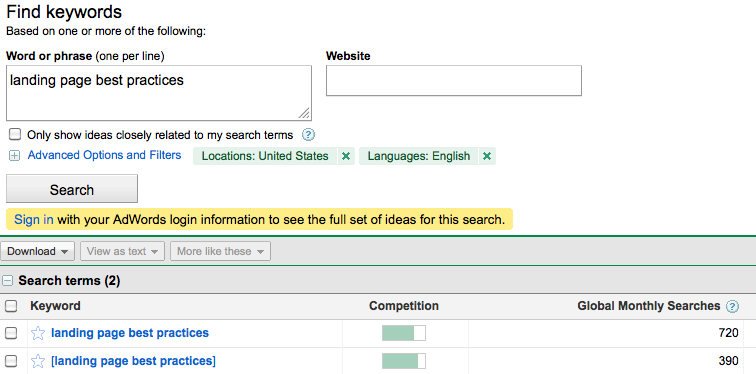Learn the formula for our Keyword Competitive Index and begin targeting keywords more effectively on your landing pages
So you’ve painstakingly taken the time to develop an extensive keyword universe that includes thousands of keywords relevant to your audience’s search habits.
That’s great, but your work isn’t done yet. After compiling a comprehensive keyword universe, you need to differentiate between keywords by each keyword’s competitive index.
If you don’t take the time to find the most qualified keywords, you may be focusing time and attention on keywords that won’t help build traffic or gain conversions. Worse yet, you may be working diligently to target keywords that you have no chance of ranking on.
The Keyword Competitive Index (KCI) is a simple formula that takes the potential annual search volume for a keyword phrase and divides it by the amount of exact Google listings for that keyword: Annual Search Volume/Exact Google Listings.
The higher the KCI, the better chance you have of ranking on the term. If you can find keyword phrases with a KCI of a one or higher, it means there is more search volume than exact Google listings. These are the type of keyword phrases worth targeting, especially if they are highly relevant to your audience and have high search volume.
Below, I provide a step-by-step process for determining your KCI.
[text_ad]
How to discover keyword competition: step-by-step
For this brief tutorial, I will use the keyword “landing page best practices”.
Step #1: Determine the potential annual search volume. To do this, start by going to the Google Keyword Tool. While here, enter the keyword phrase into the “words or phrases” box. Conduct the search and then make sure the “exact” match type is selected. Doing so will provide you with the number of average monthly searches on that exact phrase. Doing so will provide you with the number of average monthly searches on that exact phrase.

Step #2: Discover the amount of Google listings for the keyword. To do this, I entered the keyword into the Google search box with quotation marks around it. This will provide a precise number of websites listed by Google that include the exact keyword phrase.

Step #3: Do the math. For the term “landing page best practices”, I retrieved 720 exact match monthly searches and 554,000 Google Listings.
To calculate the associated annual search volume, I simply multiplied the monthly search volume by 12. Therefore, 720 x 12 = 8,640.
The annual monthly search volume for the term “landing page best practices” is 8,640.
Now, to get the KCI of this term, I will divide the annual search volume (8,640) by the exact number of Google listings (554,000) to get a KCI of .015.
This is not a very healthy KCI as there is a lot of competition on the term. However, the size of your website in terms of indexed page count, and the size of your competitors’ websites will also play part in determining whether or not you will have a chance at ranking on this term.
Going beyond the KCI
Discovering the KCI of keyword phrases supplies you with information for properly optimizing your content for search. Not only are you able to use the KCI to determine the best keywords, but you are able to see which phrases will be a waste of your time to target.
If you are looking for more information on keyword research, which includes discovering your competition, join us for our new Keyword Research Step-by-Step 2011 webinar on July 12th.



Nice explanation of how to get the KCI but now that you have this number, what are your next steps?